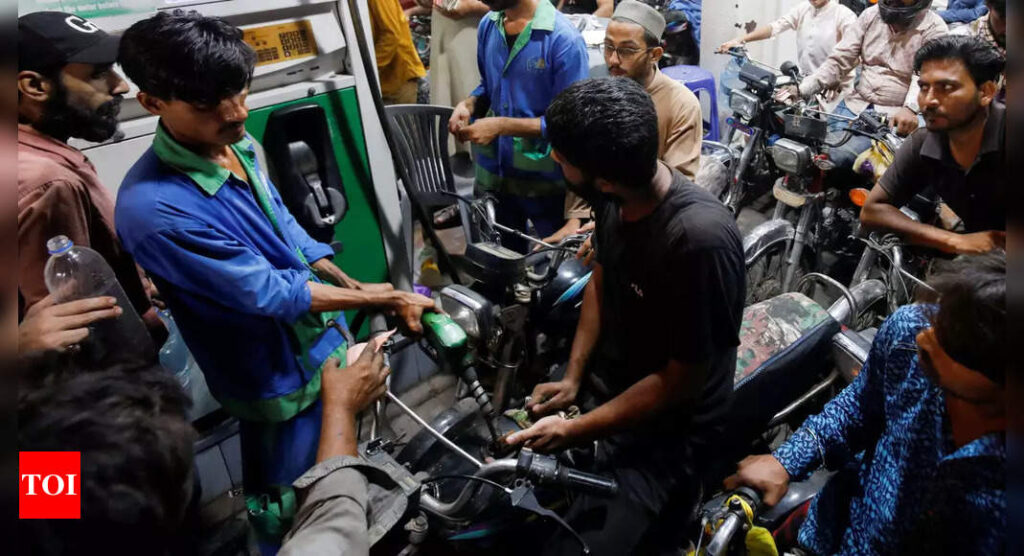[ad_1]
On August 31, caretaker prime minister Anwaarul Haq Kakar’s government refused to slash energy prices without a nod from the International Monetary Fund (IMF), and further jacked up petrol and diesel prices by over 14 Pakistani Rupees (PKR), taking the price past the psychologically significant PKR 300-mark.
Read Also
Pakistan’s interim finance minister Shamsad Akhtar has stated that the country’s economic situation is worse than expected, with no fiscal space for subsidies due to commitments with the IMF. Protests against surging electricity bills have been ongoing across Pakistan. The minister emphasized the
Inflation in electricity prices in Pakistan has been increasing progressively and the electricity bill for July can be likened to the symbolic icing on the cake of an economy that is battling with escalating prices of gas, foodgrains etc. The situation will need Islamabad to undertake a number of
The Pakistan caretaker government has hiked petrol price by Rs 14.91 per litre and high-speed diesel (HSD) price by Rs 18.44 per litre, Dawn reported. The petrol price is now at Rs 305.36 per litre and HSD at Rs 311.84 per litre, the Ministry of Finance said in a post on X (formerly Twitter) after
Pakistan’s Caretaker Prime Minister, Anwaarul Haq Kakar, denied to provide immediate relief to protesters opposing high electricity bills, citing the nation’s commitment to the International Monetary Fund (IMF).
The prices of petrol and high-speed diesel (HSD) were increased by PKR 14.91 and PKR 18.44 per litre. Additionally, the government has increased the petroleum levy on petrol by PKR 5 per litre, to a maximum permissible limit of PKR 60 per litre. The government is also charging about PKR 18-22/ litre customs duty on petrol and HSD.
The price for petrol now stands at PKR 305.36 per litre, and HSD at PKR 311.84 per litre.
The hike comes just a fortnight after prices were jacked up by PKR 17.50 and PKR 20 per litre for petrol and HSD. The combined increase works out at PKR 31.41 and PKR 38.44 per litre within a span of just 15 days.
Adding fuel to fire
The hike in HSD has proven to be highly inflationary as the fuel is mostly used in heavy transport vehicles, trains and agricultural engines like trucks, buses, tractors, tube wells and threshers, and particularly adds to the prices of vegetables and other eatables.
Electricity bills in Pakistan have also been skyrocketing. Many were hopeful that the caretaker government would provide some relief, but the Cabinet refused to slash prices stating that it would jeopardise a massive IMF loan.
The global lender had put Pakistan under tough conditions to end energy subsidies and meet revenue targets for a $3 billion-loan in July aimed at reviving its crumbling economy.
The government’s inaction has prompted more people to join rallies and protests all over the country, including in the capital Islamabad.
IMF conditions
Although the IMF approved a $3 billion bailout to support Pakistan in avoiding a default on its debt repayments, Islamabad is finding it difficult to implement all the conditions imposed by the lender.
With sky-high inflation and foreign exchange reserves barely enough to cover one month of controlled imports, Pakistan has been facing its worst economic crisis in decades, which analysts say could have spiralled into a debt default in the absence of the IMF deal.
Under the conditions, electricity prices have surged in Pakistan, which has led to social unrest in the country. The Pakistan government also had to impose additional taxes of PKR 215 billion and slash expenditures by PKR 85 billion in order to strike an agreement with the IMF.
Notably, the local currency value is also at an all-time low following an easing in import restrictions — another IMF condition — that has increased the greenback’s demand and rising risks associated with financing the country’s current account deficit.
Caretaker govt in trouble
The caretaker government attributed these “adjustments” to the escalating trajectory of global petroleum prices and its corresponding fluctuations in exchange rates.
Parallel to the towering and consistently increasing inflation and price hikes, the PKR has also been in a free fall against the US dollar with per dollar value crossing Rs 305 in the interbank and over Rs 350 in the open market.
The PKR value has fallen by 15 points under the caretaker government, which took charge on August 12.
The stock market also saw a free fall crash on August 31 as it saw its second-biggest overnight decline in the benchmark index, that plummeted by around 1,250 points (2.7%). Experts said the market fall is driven by concerns about the country’s faltering economy, rumours of an impending interest rate hike, and the persistent depreciation of the PKR.
The government does not seem to have any solution to the fast-aggravating protests and public uproar as it is tied up in the IMF programme, which has almost chained the government from taking any economic decision without taking approval from the IMF itself.
The government has decided to reach out to the IMF and brief about the escalating anger and protests across the country due to increased imposed taxes and price hikes, seeking a solution and approval to work out a strategy to give relief to the masses, without deviating from the requirements of the IMF programme.
(With inputs from agencies)
[ad_2]
Source link











More Stories
We can’t wait to face India in the final: Pat Cummins | Cricket News
Railways plans 3,000 additional trains in next 4-5 years to minimise number of waitlisted tickets | India News
Faridabad: Man dies after ‘falling from hotel room window’ while partying with friends